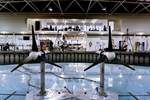Proteus Marine Renewables installs Japan’s first 1.1-megawatt tidal turbine
Carbon fiber tidal turbine generator, featuring a horizontal-axis rotor with three composite blades, drives Japan’s transition to tidal energy.
Source | Proteus Marine Renewables
(Bristol, U.K.) has successfully deployed its AR1100 tidal turbine in Japan’s Naru Strait, which will now generate 1.1 megawatts of clean energy, accelerating the decarbonization of the Goto Islands’ electricity supply and advancing Japan’s renewable energy transition.
The AR1100 tidal turbine generator (TTG) features a horizontal-axis rotor with three composite blades, designed for optimal efficiency in tidal currents. The blade angles are independently controlled by electromechanical pitch systems housed in the turbine hub, enabling real-time control for maximum energy capture and to minimize hydrodynamic loads.
“The carbon fiber and resin composite offers several key advantages, including high strength and stiffness, high fatigue life, corrosion resistance, relatively lightweight and the material will sink if broken, preventing floating debris hazards,” Nigel Hopley, head of product component at Proteus, . “Tidal turbine blades are shorter and stubbier than wind turbine blades, yet they experience similar reaction forces at the blade roots. However wind turbine blades are much thicker, which increases their second moment of area (a key factor in bending resistance), so the strength of the material for a wind turbine blade can be lower.”
According to Proteus, the tidal turbine manufacturing process involves several stages. Main components are first placed in molds and infused with resin, usually in a single infusion process. Some parts are then machined for greater precision, and the components are glued together using f-alignment fixtures to enable correct attachment to the rotor hub. A hand-finishing stage is required the strengthen the bonded joints. The final components are painted for protection and aesthetics.
The AR1100 builds on the success of the AR500 pilot project in 2021, where a 500-kilowatt device operated in the Naru Strait, maintaining a 97% turbine availability. Proteus signed an equipment supply and works contract with Kyuden Mirai Energy (KME) in November 2022 to upgrade the device to 1.1-megawatt capacity. Leveraging its modular architecture, Proteus also enhanced its existing turbine’s performance and efficiency by integrating advanced pitch and yaw systems, along with other improvements, to achieve this rating.
“The result reinforces tidal energy’s potential as a dependable renewable source in Japan. Our next immediate focus is the commissioning of the turbine, Japan’s first ever MW-scale grid connected tidal system, and the subsequent testing and accreditation phase.”
“Deploying the AR1100 in Japan is a testament to the dedication and expertise of our team working in collaboration with local professionals,” says Philip Archer, managing director of Proteus operations in Japan. “The result reinforces tidal energy’s potential as a dependable renewable source in Japan. Our next immediate focus is the commissioning of the turbine, Japan’s first megawatt-scale grid connected tidal system, and the subsequent testing and accreditation phase.”
The deployment, carried out by local vessels and resources under the supervision of the Proteus Offshore Services team, was made possible through the collaboration and expertise of key partners and suppliers in Japan. Kyuden Mirai Energy, with support from the Ministry of Environment, is playing a crucial role in advancing Japan’s transition to tidal energy.
Related Content
-
RTM, dry braided fabric enable faster, cost-effective manufacture for hydrokinetic turbine components
Switching from prepreg to RTM led to significant time and cost savings for the manufacture of fiberglass struts and complex carbon fiber composite foils that power ORPC’s RivGen systems.
-
High-tension, vertical filament winding enables affordable flywheel energy storage system
French startup Energiestro’s prototype solar energy flywheel-based storage system aims to reduce costs with glass fiber composites and prestressed concrete.
-
Composites end markets: Energy (2024)
Composites are used widely in oil/gas, wind and other renewable energy applications. Despite market challenges, growth potential and innovation for composites continue.






